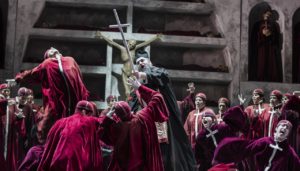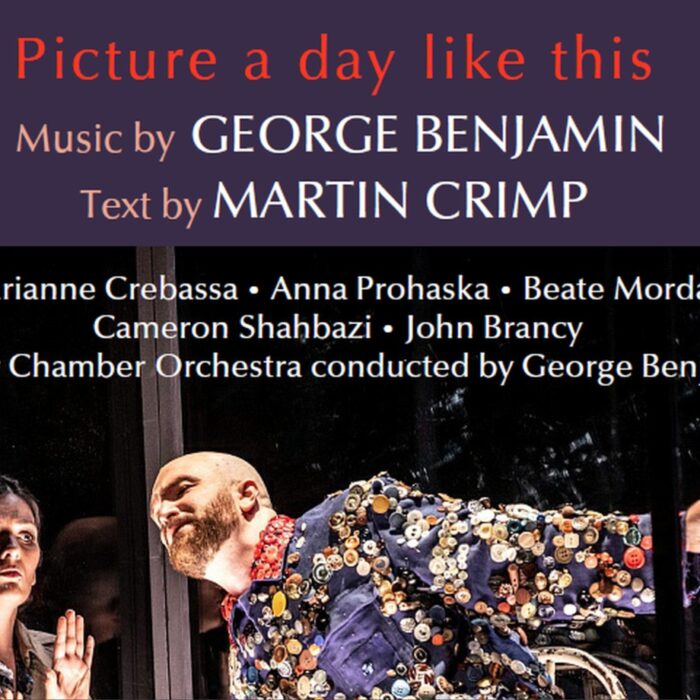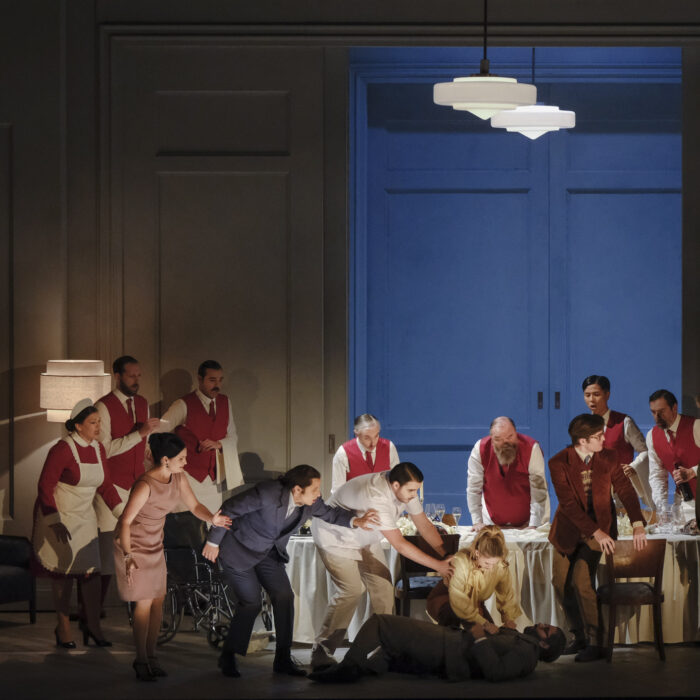
Teatro dell’Opera di Roma 2018-19 Review: The Fiery Angel
Dante’s Strong Direction & Pérez’s Musical Leadership Deliver Winning Performance
By Alan Neilson(Photo: Yasuko Kageyama-Teatro dell’Opera di Rome)
Sergei Prokofiev finished his opera, “The Fiery Angel” in late 1927, and missed the deadline for its inclusion in the Stadtische Oper, Berlin’s 1927-28 season, leading to the cancelation of the contract. An abridged concert performance was given in 1928 in Paris, but Prokofiev was disappointed by its critical reception. Although there was tentative interest in 1930 from New York’s Met to stage the work, it came to nothing and the score was then “consigned to oblivion.” Having had such high hopes for the work, a disappointed Prokofiev was never to see a staged performance; its premiere took place a year after his death in 1954 at Venice’s La Fenice. Since then the work has seen its reputation grow, and is now seen by many as being his best opera, receiving regular performances worldwide, although without really managing to fully established itself.
A Complex Backstory
The backstory to the opera is not only interesting in its own right, but is also able to illuminate our understanding. It is based on a novel by the symbolist writer, Valery Bryusov, which itself was inspired by the author’s romantic entanglement with Nina Petrovskaya, with whom he was hopelessly in love. Petrovskaya, however, was in a relationship with a well-known author, Andrey Bely, with whom she was completely besotted, seeing him as “a new Christ” or as a “Fiery Angel.” Bely underwent a spiritual crisis and fled, but Petrovskaya pursued him relentlessly.
At this point she took up with Bryusov, but her obsession with Bely never dimmed, the result of which was a three-way relationship full of intense jealousy, passion, anger and mental torture for all three of them. They were also believers in the black arts, and Bryusov even attempted an exorcism to rid himself of Bely.
Later in life in Bryusov transposed their experiences into a novel, with the three main characters, Ruprecht, Renata and Heinrich, ciphers for Bryusov, Petrovskaya and Bely. Being a novel it includes many fictional moments, but it nevertheless, captured the nature of their relationship, and the dominant themes of the symbolist movement: sexual repression/liberation, obsession, the inner-self, and the occult, and it is these themes which Emma Dante, the director, made central to her reading of the work.
Into the Depths
The entire performance was set underground, in a crypt, or similar looking structure, which acted as a symbol for the subterranean emotions and drives of the self. The realm of the occult and the dark arts were boldly portrayed, so that the “sacred edge that divides our world from the dark sphere in which float spirits and demons” was clearly and centrally focused. In the opening scene, Ruprecht arrives at the inn looking for a bed. He is provided with a tomb-like cavity on the wall, on which other sleeping or dead figures are also positioned. The bodies occasionally twitch jerkily, and finally come to life. Is this real or a projection of his own fears? Either way, it is an opening image which captures the ambiguous nature of reality, which lies at the heart of the work.
Moreover, Dante successfully overcame the perceived dramatic shortcomings of the work, which arise from its episodic structure, and from the dominant position given to the character of Renata, the effect of which can lead to the downplaying of the suffering experienced by Ruprecht. This was partially achieved through the use of a unified set, designed by Carmine Maringola, which managed to preserve the underground setting, whether placed in Agrippa’s study, a beer garden or outside in the street.
More significantly, however, was the introduction of dancers who performed the role of the Angel Madiel and other demons. They were used to terrorize, not just Renata, but also Ruprecht, thereby bringing a greater degree of equality to the roles, which was reinforced through Dante’s direction who highlighted his suffering through painful physical bodily contortions, while at the same time curtailing the physical depiction of Renata’s terrors. The overall effect was to create an integrated and evenly-balanced presentation which allowed the narrative to flow easily.
Dante and Maringola combined with the costume designer, Vanessa Sannino, to produce a wonderfully grotesque staging in which no opportunity was missed to introduce a variety of demons, ghouls and other horrors. Symbols of the occult and death proliferated. Sannino’s costumes were generally of late 18th century design, which suitably complemented the setting, with one or two oddities, such as in the case of Faust and Mephistopheles’, whose costumes were deliberately from other periods. Also the dancers, being other worldly figures, had fantasy costumes.
The one slightly disappointing aspect of the staging, however, was the lighting, designed by Cristian Zucaro, which remained fairly neutral and without sufficient variation. The scene with the fortune teller was far too bright and failed to produce any sense of the occult or dark arts on display. The lighting for Agrippa’s study, however, was excellently designed, conjuring up the hidden darkness that lay behind the books.
One or two further minor criticisms could be made, but they amounted more to missed opportunities than actual failings in the staging itself. It was decided, for example, to have the non-speaking role of Heinrich, appear at frequent intervals, in order to provide context for Renata’s outbursts, or to cast a cynical eye over proceedings. It was an imaginative idea which worked well and added to the clarity of the narrative. Unfortunately, it also diminished the impact of his first appearance. Instead of appearing as a silhouette of fiery angel, against a widow at the top of a flight of stairs, with Renata cowering below, he makes an almost casual appearance in an alcove, which fails to explain Renata’s reaction.
Explosive Performances
The Orchestra del Teatro dell’Opera di Roma’s explosive playing in the final act rounded off a thrilling performance under the baton of Alejo Pérez. Pérez produced a dramatically sensitive, well-balanced performance, which captured the emotional tensions of the score. The orchestra’s sound was in turn anxious and fraught, aggressive and magical, occasionally sweetly melodic, but always closely co-ordinated with the onstage drama, in which the work’s dramatic tensions were creatively exploited.
Renata is a truly demanding role, requiring stamina and a singer with a wide vocal range. Moreover, it is a role which can easily dominate the stage to the extent that the opera becomes all about her, with the other characters providing no more than contextual padding. The Polish soprano, Ewa Vesin, in collaboration with Dante’s strong direction, ensured that her Renata slipped comfortably into the drama, allowing the other characters to develop and the narrative to breath, yet retaining her position as the opera’s central character.
Her voice was nicely suited to the role, displaying the necessary strength and range, and the flexibility to cope with the punishing demands of the part, and effectively portrayed the character’s struggle with her inner, or possibly real, demons. In her first extended monologue, “I was eight years old,” she relates her first meeting with the demon/angel, Madiel, and then later with Heinrich. It is her first solo set-piece, and Vesin immediately laid down a marker, her singing was simultaneously expressive and distant, caught between her inner and outer worlds.
As the opera progresses Renata’s mental state veers one way, then the other, which Vesin characterized skillfully, through well-constructed, detailed phrasing and secure soaring lines, underscored by her attractive vocal timbre. The opera ends with her death. Dressed in black robes, with a golden crown, she stands motionless, like a statue of the Madonna, and encouraged by the demon which pursues her, she plunges a knife into her breast. They both fall to the floor, dead. Although, an excellent performance, the decision to slightly downplay the role meant that Vesin did not exploit the hysteria and inner struggles to the full, which was dramatically the correct course, but it also meant that her vocal performance was never allowed to hit the extreme heights.
Male Counterparts
The baritone, Leigh Melrose, put in an splendid performance in the role of Ruprecht. Initially forceful and confident in his pursuit of Renata, Melrose’s Ruprecht fell increasingly under her spell, becoming a victim of her whims, a slave to her wildly changing emotions, in which his obsession descended into a tortuous mental condition.
Vocally he was outstanding; his baritone displayed flexibility and security across the range, and his middle register, in particular, was warm and appealing. Phrasing was detailed and intelligently crafted, and clearly captured Ruprecht’s pain, obsession and frustration. Importantly, he brought depth to the character and his presence was strong enough to provide a counterbalance to Renata, which elevated the dramatic impact of the work.
Maxim Paster playing the role of the Mephistopheles made a powerful visual impression, with his long, white, three-pointed beard and eccentrically flamboyant costume, which included silver shoes. His arresting entrance, alongside Faust, was nicely done, although totally at odds with the libretto, which states that they enter quietly, unobserved.
His strong vocal portrayal was full of detailed inflections, and caught the underlying malevolence in his utterances. The lower and upper registers were firm, but the upper register occasionally thinned. Unfortunately, in the final act he was positioned in a side box, looking down on the stage, but with all the frantic activity involving the Inquisitor and the hysterical nuns, his presence went by almost unnoticed, and the dynamic power of the orchestra meant that he was also largely unheard.
His partner-in-crime, Faust, was played by Andrii Ganchuk, a member of Teatro dell’Opera di Roma’s “Young Artists Program.” He has a fine sounding, powerful bass-baritone which he used to good effect, and produced a persuasive performance. He was also parted in the small role as a servant.
Supporting Members
Mairam Sokolova was double parted in the roles of the Fortuneteller and the Mother Superior. Possessing a colorful mezzo-soprano, with an attractive timbre, she produced an engaging open sound, and characterized the roles with a sufficient degree of vocal differentiation. In particular, her essaying of the fortuneteller, in which she was costumed in a 19th century Parisian outfit, impressed, although the staging of the scene was not particularly successful.
During Act two, Ruprecht consults the theologian, Agrippa of Nettesheim, the 16th century theologian who has a strong interest in the occult. It was a powerfully presented scene in which his study is assailed by spirits and demons, who attack and menace his visitor. The tenor, Sergey Radchenko was parted in the role, and created a believable impression as the eccentric occultist. He sang well and acted out the part convincingly, producing a solid performance.
The bass, Goran Juric, dominated the stage in his role as the Inquisitor, who arrives at the convent to perform an exorcism on Renata. During the attempt the nuns are overcome by demonic possession, or by mass hysteria. Striding across the stage, waving a wooden cross above their heads, Juric certainly looked the part, his large frame powering its way through the chaotic senes which unfolded about him. Vocally he was well-suited to the role; his voice strong, firm and authoritative.
Domingo Pellicola, another student from from Opera Roma’s “Young Artist Program” produced a well-defined performance in the role of Jakob. He sang with confidence, and his voice was firm and well-focused. The mezzo-soprano, Anna Viktorova, played the role of Landlady. She gave a forceful portrayal, was vocally secure with clear articulation and a pleasing tone.
The other minor roles of the Inn Keeper, Mathias, and the Doctor were performed by the young Russian baritone, Timofei Baranov, the baritone Petr Sokolov and tenor, Murat Can Guvem respectively, all produced accomplished performances.
Overall, Opera Roma’s production of “The Fiery Angel” was hugely successful. Under Dante’s strong direction it was given a clear, colorful presentation in which its themes and narrative were expertly and imaginatively handled. Pérez’s musical leadership was equally assured, eliciting first class performances from the singers and orchestra alike. Together they combined to create a presentation of Prokofiev’s masterpiece which sparkled in all its grotesque glory.


